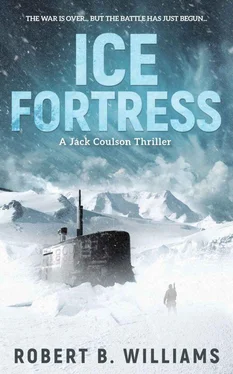November 9, 2017, 09:15 UTC
South Pacific Ocean
2,000 miles from target
Location: Classified
USS Indiana (SSN 789)
“ Man battle stations missile .”
“ Man battle stations missile .”
A raucous alarm whoop whooped throughout the boat causing a frenzy of organized chaos from aft to stern.
‘This is not a drill. I repeat, this is not a drill.”
Following an unspoken convention that could only ever be understood by experienced submariners who had earned their ‘Dolphins’, sailors hugged bulkheads to let others pass in both directions, men slid down companionways, others climbed up. The whole boat moved to a hectic choreography of men moving in all directions at once without ever colliding or causing bottlenecks and it was all performed to a blaring cacophony of alarm bells.
“This is the Executive Officer. The launch of nuclear weapons has been authorized and verified. This is not a drill.” The XO cradled the mic solemnly and turned to the commander.
“Thank you Mr. Merrill. You have the Conn — take us to launch depth and enter the target package for tube one.”
“Aye, sir. I have the Conn.”
The commander made his way to his stateroom where the missile keys were housed in a locked safe. Only he knew the combination.
“Take us to launch depth,” the XO ordered as he punched the target package into the missile control system console. Beads of sweat crowded his brow.
What felt like an hour later, but in reality had only been a few minutes, Commander Ryan returned with a launch key swinging from his neck by a red lanyard.
Merrill had seen the launch keys a hundred times before during missile drills but only now in this grim scenario did he note, ironically, that the keys that fired a missile bearing a nuclear payload was almost indistinguishable from his own gym locker key. He wondered why they made them look so bland and innocent.
The Launch Control Officer had retrieved his key from his own safe the minute the XO had called battle stations missile. Only he had the combination. Manning his station at the Attack Center, he verified the target package and waited for the commander to give the order to initiate the firing sequence. Both the Launch Control Officer and the commander had to insert and turn their keys at the same time before the missile could be launched.
As soon as the target package had been entered by the XO and confirmed by the Launch Control Officer, the missile in Vertical Launch Tube one began to spin up its gyro and initialize its onboard GPS to lock in its exact launch position. With that information and the target package successfully uploaded, the nuclear tipped Tomahawk would fly undeterred to the target area and deliver its warhead to devastating effect.
The ready light on the indicator screen turned green.
The Commander and the Launch Control Officer inserted their keys and on the Commander’s count of three, turned them clockwise a quarter turn.
The LCO flipped up the bright red safety cover guard exposing the missile launch switch.
Commander Ryan gave the command, “Fire missile one.”
The LCO pushed the fire control, his nerves strong and his fingers steady. This is what he’d been trained to do.
The missile, one of six clustered in the latest Virginia Payload Module, was propelled from the submarine. Initially launched with a fiery and spectacular solid-fuel rocket booster, once airborne and clear of the water it appeared to hover in space for a moment, then it deployed its stubby wings, whirred up a powerful turbo-fan engine and accelerated toward its cruising speed.
This particular missile was programmed to use its jam resistant GPS to navigate to target in sea-skim mode at subsonic speed just above the waves until it hit its target with pinpoint accuracy.
The 2,000 mile, 4 hour countdown had begun.
The men aboard the USS Indiana didn’t see the spectacular launch of the missile or hear the boom as its solid booster lit up and spewed flames and white smoke from its tail. They remained in the silent, dark depths of the South Pacific and would do so until ordered to stand down or launch another missile. In the meantime, they would have time to reflect on being the first submarine to launch a nuclear missile with hostile intent.
November 9, 2017, 09:30 UTC
U-Boot-Bunker (Submarine Pen)
Kriegsmarine Base 211
Ronne Ice Shelf (Antarctica)
77°51′ 19.79" S -61°17′ 34.20" W
U-2532
“Peterson, SITREP,” Muller said quietly into his throat mic. He’d heard a hell of a lot of shooting from the docks and needed a situation report ASAP.
No response.
“Peterson. Respond.”
Still no response. Losing his second in command wasn’t something he’d factored into his action plan. Muller needed to check the status out in the bunker first hand.
There was nothing more they could do in the U-Boat, anyway. The compartment hatch was welded shut. They’d need to blast it open to get to the device and the explosives had been left up on the ice, along with the rest of their equipment. The reconnaissance into the bunker was only supposed to be a search and recovery mission, securing the U-Boat against minimal resistance. They’d expected to encounter the two crazy men on the U-Boat but they hadn’t expected to come face to face with an attack submarine when they penetrated the concrete bunker.
Circling his hand anticlockwise and gesturing upward, Muller signaled his men to rally at his position then climb the ladder to the conning tower. There was no point risking radio communication if things hadn’t gone to plan up above. He’d follow right behind them, allowing them to draw any enemy fire on their position first, of course.
As the last man paused at the top of the ladder, Muller paused, too. So far silence.
He gave three sharp taps on the man’s leg, signaling for him to continue up.
Reaching the inside of the conning tower, it took Muller only a few seconds to assess the damage. Not a single man remained on post at the perimeter he’d ordered them to establish after disposing of the sailors on the American sub.
Someone had taken his men out. They were handpicked, elite soldiers and getting the better of them wouldn’t have been easy. Muller would not underestimate the Americans again.
Muller felt two taps on his shoulder and turned to the man next to him. Pointing to his own eyes, then to the sail of the American sub, Muller looked but couldn’t see anything. Then there was a slight movement. At least one man was sheltered behind the sail. But one man couldn’t take out thirty of his. There had to be others.
Another series of taps on his shoulder and he followed the raised hand of another of his men. An irregular shape against the hard and uniform edge of the concrete revealed another man, lying flat, sheltered behind some kind of depression or step in the concrete floor.
Muller didn’t want to risk damaging the American sub, so the man cowering there would live a little longer. The man on the ground wouldn’t be so lucky.
Muller unclipped something from one of the loops on his body armor. It looked small in his oversized palm and more like a piece of exotic tropical fruit than a weapon. But it was, indeed, a weapon and an extremely potent one at that.
Hand grenades haven’t evolved much since the First World War. They’re simple weapons. Pull the pin, then throw it and wait for it to explode. If the concussion wave doesn’t kill you, the shrapnel will, cutting both friend and foe to ribbons as it flies in all directions. A traditional grenade is as likely to kill your own men as it is the enemy. That’s what Muller loved so much about his Swedish designed and German built Rheinmetall SHGR07 Airburst grenades. Only the enemy was cut to pieces by the shrapnel or killed by the concussive blast. And it did the enemy no good to hide behind cover. The SHGR07 was purpose built to deal with that.
Читать дальше












